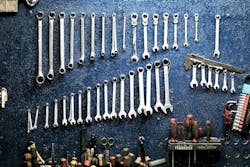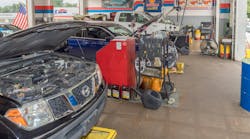Sales is hard. If you (or the advisors in your shop) are struggling to sell maintenance services, maybe it’s time to take a look at your approach. Instead of focusing on sales, focus on people skills. Build strong relationships with your customers. The sales will follow.
We’ve all been in that awkward situation at a retail store when the salesperson tries to get you to sign up for a new credit card. They have to ask everyone to sign up, so they do. And you can tell they’re just going through the motions. The more people they ask, the more they can get to sign, right? Maybe, but that’s not how you earn lifelong customers. It takes time and good relationships.
You may want to bite the bullet and get the difficult part over with first. But if you only focus on making the sale, you’ll appear pushy to your customers. The ask-for-the-sale part may occur before the customer has a chance to trust you. This can be off-putting. Just ask all those people who wanted that extra 5% off and now have a thousand maxed out credit cards! They’re not going to trust that salesperson again. This tactic sets you up for failure, making you even more nervous about sales.
Barriers to customer connection
Stereotypes can be pretty harsh, especially about people who work in the automotive industry. Everyone has heard stories about the loud, pushy sales team who won’t let you leave the car lot without signing a purchase contract. It’s the stuff of nightmares!
Then there’s the story you heard from your co-worker about how their aunt’s cousin’s shoe repair guy got ripped off by some mechanic someplace, which nobody ever checks out but everybody believes.
You can know what you’re doing and still hit a wall of refusal. Too many customers come in with their shields up, ready to do battle. They can’t help it. They heard about their aunt’s cousin’s shoe repair guy and are mentally prepared to be cheated. There’s a confidence gap to overcome.
Your customer may not be ready to hear she’s got repairs to pay for. Car repairs and maintenance plans can be surprise expenses. This news may be easier to present with the RIM model, a sales tool for categorizing your customer’s needs. You can prioritize your recommendations based off of which category they fall into: related, immediate or maintenance.
- Related recommendations are anything that relates to the customer’s concern. She came in for a specific issue, and she’ll most likely listen to repair suggestions to address that issue.
- Immediate recommendations address any safety concerns. Safe handling of the car is critical. She may not want to hear she’s got a problem but tell her anyway. You’ll want to give her a heads up on any safety risks.
- Maintenance recommendations are services that would be good to plan for but aren’t immediately necessary.
Paths to positive customer relationships
Get to know your customer. Have a chat with her first. Find out her driving habits. How can you know what’s best for your customer if you don’t know anything about her? It’s like a first date; if you want it to go well, you’re going to have to get to know the person. Learn what you can about your customer so you can make appropriate recommendations.For example, if she’s a “short-hop” driver, talk to her about how varnish deposits can build up after too many short trips.
Or if she has young drivers in the household, go ahead and assume her brakes are taking a beating (along with her insurance plan). Ask about fuel consumption and suggest driving habits that’ll help save fuel and brakes. A parent will appreciate having someone on her side!
These conversations show you are willing to invest some time in your customer. You get to demonstrate your expertise at no cost to her other than the time it takes to listen to you. And hey, listening to you may actually save her some money down the road!
Car maintenance milestones
Vehicle manufacturers suggest repairs at specific mileage markers, such as 30,000 miles or 60,000 miles. If you’re doing the same, say so. “The manufacturer recommends X-service at 30,000 miles. Have you had a chance to get that done?” If yes, the conversation is complete and the customer doesn’t feel fleeced or oversold.
If no, the next question is, “Would you like us to take care of that today?” Communication is key. Many people with newer cars are still making payments. Extra service may be too expensive. Be as up front as possible regarding this expense so your customer can plan for it.
What you’re hoping to hear next is, “Why do I need that?” This is your chance to shine. The days of shade tree mechanics are long gone, and many drivers don’t want to repair their own car. Getting stranded is everyone’s nightmare. Use your expertise to educate your customer. Be ready to let her know the long-term impact of poor maintenance.
Taking the long road
Stay flexible so the customer doesn’t feel pushed. Give her options. Let her know the details for a service and then offer to email her in a month to set up an appointment. Can you offer a surprise discount? Put that in the subject line and your email may get a response!This type of reminder puts the customer in charge of her service and maintenance schedule. If you offer email promotions or coupons, make sure she actually wants these before you put her on the drip list. If not, your reminders will get ignored. You don’t want to fall into the abyss of unread emails! That’s a dark and lonely place where good intentions go to die.
Personal connection
I’m willing to bet your customer can’t get by without her car. Sweeten the pot if you need to keep the car for a while. Add-ons like a loaner car or concierge service with pick-up and drop-off can make-or-break a busy customer’s choice.When you can, find out about future car needs. If you notice infant car seats in the vehicle, stress the importance of preventive maintenance. Getting stranded is a pain, but getting stranded with a baby can be dangerous. Is summer vacation coming? Ask about long car trips in hot weather. Offer to put in the custom filter that blocks the “Are we there yet?” question. (Sadly it's on backorder, darn it.) Do you see a bike rack on the back of the car? She may be headed for rough terrain, so promote transmission and brake services.
Provide evidence
Not knowing what’s under the hood of a car makes a customer nervous to come in. Ignoring a problem won’t make it go away. Help your customer face her fears! If you find signs of a serious problem, be ready to document it visually. Share the evidence of a damaged part beside a new part for reference.
For example, if a CV boot is cracked, get a picture or video to show the customer the risk to the velocity joint. You know the dangers of failure to any part of the car. Share that knowledge!
Customize your communications
Most people these days have cell phones. Find out if your customer wants a call or a text when her car is ready for pick-up. Make it easy on her. Snap a photo or send a video if you need to explain repairs in more detail. Or, if the service goes as expected, a simple “your car is ready” text will work. If anything unexpected happens, then you can call.If your customer is 60+, she’s probably going to want a phone call regardless of the outcome. Keep track of how your customer wants to be contacted. Mark it on her paperwork so anyone at your shop can easily get ahold of her.
Become the expert
The end goal is to be the go-to shop or person for when there’s a funny noise or a warning light on the dash. Funny noises can be expensive, but they can get really pricey when the noise quits… it could mean the part has completely given up!You have the expertise to know if that funny noise is just a belt that needs replaced or a bad wheel bearing. Even if you solve the problem but don’t make any money doing it, your status as an expert can give your customer peace of mind. She’ll be able to confidently make plans for both regular and unplanned maintenance.
Is it frustrating to have to climb over a mountain of stereotypes to provide great service to a customer? Of course. But building relationships and focusing on slow sales will help you develop a loyal and happy customer base. You’ll overcome those barriers, build trust, and be on your way to selling more services.
Content brought to you by BG Products, Inc. For more information, visit www.bgprod.com





